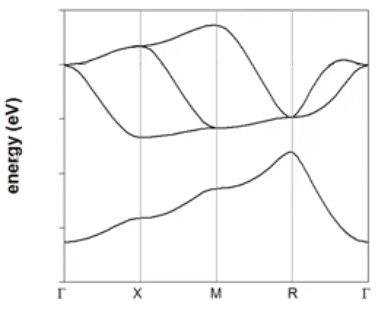Problem 1
You need to design a Bragg mirror that consists of many alternating layers of two transparent materials but should reflect light with an angular frequency of $\omega = 10^{15}$ rad/s. The layers all have a thickness $L$. Light propagates at 2.9 × 108 m/s in one of the materials and 2.0 × 108 m/s in the other material. For long wavelengths $\lambda \gg L,$ light propagates at the average speed of 2.45 × 108 m/s.
(a) What is $k$ at the first Brillouin zone boundary in terms of $L$?
(b) Sketch the dispersion relation $(\omega\text{ vs. }k)$ for this layered material.
(c) Indicate in your drawing above which part of the dispersion relation corresponds to long wavelengths.
(d) How large should $L$ be so that the Bragg mirror reflects light with an angular frequency of $\omega = 10^{15}$ rad/s?
(e) Sketch the solution of the wave equation for $\omega = 10^{15}$ rad/s.
Solution
Problem 2
Polonium is the only element that forms a simple cubic crystal structure. The lattice
constant is
$a = 3.359$ Å.
(a) Calculate the primitive reciprocal space lattice vectors.
(b) At which scattering angle 2θ is the diffraction of the 322 reflection observed, if the wavelength of the X-rays is 1.0 Å?
(c) A band structure calculation for polonium is shown below. This calculation was made assuming that the relevant orbits were the 6s and 6p atomic orbitals. Polonium has one atom in the basis and 6 valence electrons. Draw the Fermi energy into the band structure. Explain why you have drawn the Fermi energy where you have.

(d) Sketch the phonon band structure ($\omega$ vs. $k$) of polonium. Use the same symmetry points as in the electronic band structure above.
(e) You measure the specific heat $c_v$ of Po experimentally. How can you determine the electron contribution to the specific heat and the phonon contribution to the specific heat separately?
Solution
Problem 3
(a) A crystal has 5 atoms in the basis. How many $\vec{k}$ states does this crystal have per primitive unit cell?
(b) ZnO undergoes a structural phase transition from wurzite to zincblende. How could you determine the temperature at which this phase transition occurs?
(c) An electron scatters from state $\vec{k}$ to state $\vec{k}'$ and generates a phonon with wave vector $\vec{k}_{\text{ph}}$. The conservation of momentum for this case is $$\hbar \vec{k}' + \hbar \vec{k}_{\text{ph}}= \hbar \vec{k} + \cdots.$$
What does $\cdots$ represent in this equation?
(d) There is a contribution to the thermal conductivity from the electrons and from the phonons. Why is the thermal conductivity of a metal related to its electrical conductivity?